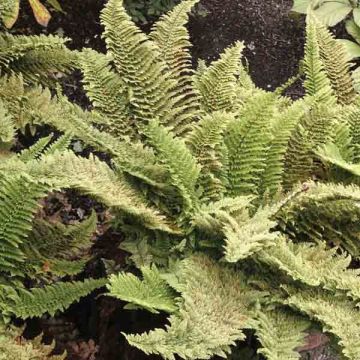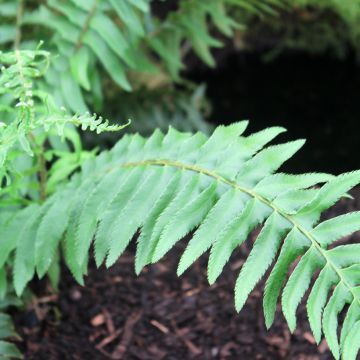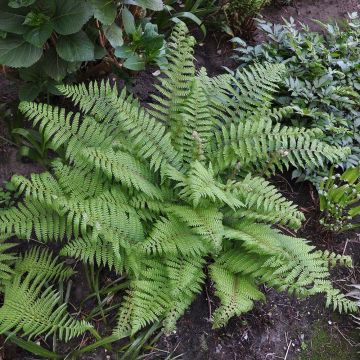

Polystichum setiferum Plumosum Bevis - Aspidie à cils raides


Polystichum setiferum Plumosum Bevis - Aspidie à cils raides
Polystichum setiferum Plumosum Bevis - Soft Shield Fern
Polystichum setiferum Plumosum Bevis
Soft Shield Fern
Absolutely stunning fern with beautifully cut foliage.
Béatrice, 27/03/2024
Special offer!
Receive a €20 voucher for any order over €90 (excluding delivery costs, credit notes, and plastic-free options)!
1- Add your favorite plants to your cart.
2- Once you have reached €90, confirm your order (you can even choose the delivery date!).
3- As soon as your order is shipped, you will receive an email containing your voucher code, valid for 3 months (90 days).
Your voucher is unique and can only be used once, for any order with a minimum value of €20, excluding delivery costs.
Can be combined with other current offers, non-divisible and non-refundable.
Why not try an alternative variety in stock?
View all →This plant carries a 12 months recovery warranty
More information
We guarantee the quality of our plants for a full growing cycle, and will replace at our expense any plant that fails to recover under normal climatic and planting conditions.

Would this plant suit my garden?
Set up your Plantfit profile →
Description
Polystichum setiferum Plumosum Bevis is a cultivar of Polystichum with very remarkable bristles, discovered in 1876 in a hedge in Devon, England by an individual named Bevis. It is an ornamental fern that is as easy to acclimatise in our gardens as its wild ancestor, also known as the Soft Shield Fern in our forests, often planted in gardens. 'Plumosum Bevis' clearly surpasses it in elegance with its longer fronds, which seem braided at the tips before they unfurl. Its intensely divided foliage, soft and smooth to the touch, evokes vibrant green feathers. It is a robust, hardy and mostly evergreen plant in winter. It will thrive in shaded areas, in any humus-rich, well-drained soil, and even even soil that is quite dry in summer.
Polystichum setiferum, formerly known as Polystichum angulare, is a botanical species native to Great Britain and Western Europe, especially the southern regions, as well as temperate Asia and North Africa. Its natural habitat consists of woods and shaded ravines. It is a perennial plant of the Dryopteridaceae family, the origin of more than 300 cultivars, more or less differentiated. The 'Plumosum Bevis' cultivar shows rather slow growth, especially in the first few years. The plant forms a slightly spreading tuft, with an upright habit, reaching a height of 80 cm (32 in) to 1 m (3 ft) and a width of about 70 cm (28 in). The young croziers that emerge in spring are brown, and then they unfurl revealing silvery and sparkling scales. The young fronds are very upright, and then they slightly arch as they unfurl. Their lamina, widened in the centre, is divided into 30 to 40 pairs of pinnate pinnules, oriented upwards, slender, and covered with bristles that give them a shiny appearance. The petiole of each frond is very scaly and brown. The colour of the foliage changes from acid-green with golden reflections to a darker green.
The polystichums make up a very varied and particularly decorative genus throughout the year for most species and varieties. Polystichum setiferum Plumosum Bevis is a plant that adapts to many shaded situations, in well-drained soil. Its large feathery and silky fronds that emerge from the shade invite touch, along a shaded path. In the undergrowth, it can be associated with simple and undemanding plants such as butcher's broom, hollies, Mahonias or lamiums. This fern also pairs well with bamboo, shrubby fuchsias, nandinas, and hostas. Ferns are always beautiful at the edge of water features or in large shaded rockeries.
Report an error about the product description
Foliage
Plant habit
Botanical data
Polystichum
setiferum
Plumosum Bevis
Dryopteridaceae
Soft Shield Fern
Western Europe
Other Polystichum
View all →Planting and care
Polystichum setiferum Plumosum Bevis is easy to grow in shady or partially shady areas, in a humus-rich to clayey soil that is well drained, slightly acidic, neutral or slightly alkaline. Preferring soils that remain slightly moist, this cultivar also adapts to drier conditions in summer. It particularly appreciates a light substrate composed of humus, sand, and dead leaves. Protect the crown with a thick layer of dead leaves in winter, in regions with humid and very cold winters, to protect the stump from excessive winter moisture. The old fronds of these ferns should be cut back in early spring to ground level, so that you can fully enjoy the extraordinary spectacle of the new frond shoots each year. It is hardy down to approximately -15/-18 °C (5/-0.4 °F).
Planting period
Intended location
Care
-
, onOrder confirmed
Reply from on Promesse de fleurs
Similar products
Haven't found what you were looking for?
Hardiness is the lowest winter temperature a plant can endure without suffering serious damage or even dying. However, hardiness is affected by location (a sheltered area, such as a patio), protection (winter cover) and soil type (hardiness is improved by well-drained soil).

Photo Sharing Terms & Conditions
In order to encourage gardeners to interact and share their experiences, Promesse de fleurs offers various media enabling content to be uploaded onto its Site - in particular via the ‘Photo sharing’ module.
The User agrees to refrain from:
- Posting any content that is illegal, prejudicial, insulting, racist, inciteful to hatred, revisionist, contrary to public decency, that infringes on privacy or on the privacy rights of third parties, in particular the publicity rights of persons and goods, intellectual property rights, or the right to privacy.
- Submitting content on behalf of a third party;
- Impersonate the identity of a third party and/or publish any personal information about a third party;
In general, the User undertakes to refrain from any unethical behaviour.
All Content (in particular text, comments, files, images, photos, videos, creative works, etc.), which may be subject to property or intellectual property rights, image or other private rights, shall remain the property of the User, subject to the limited rights granted by the terms of the licence granted by Promesse de fleurs as stated below. Users are at liberty to publish or not to publish such Content on the Site, notably via the ‘Photo Sharing’ facility, and accept that this Content shall be made public and freely accessible, notably on the Internet.
Users further acknowledge, undertake to have ,and guarantee that they hold all necessary rights and permissions to publish such material on the Site, in particular with regard to the legislation in force pertaining to any privacy, property, intellectual property, image, or contractual rights, or rights of any other nature. By publishing such Content on the Site, Users acknowledge accepting full liability as publishers of the Content within the meaning of the law, and grant Promesse de fleurs, free of charge, an inclusive, worldwide licence for the said Content for the entire duration of its publication, including all reproduction, representation, up/downloading, displaying, performing, transmission, and storage rights.
Users also grant permission for their name to be linked to the Content and accept that this link may not always be made available.
By engaging in posting material, Users consent to their Content becoming automatically accessible on the Internet, in particular on other sites and/or blogs and/or web pages of the Promesse de fleurs site, including in particular social pages and the Promesse de fleurs catalogue.
Users may secure the removal of entrusted content free of charge by issuing a simple request via our contact form.
The flowering period indicated on our website applies to countries and regions located in USDA zone 8 (France, the United Kingdom, Ireland, the Netherlands, etc.)
It will vary according to where you live:
- In zones 9 to 10 (Italy, Spain, Greece, etc.), flowering will occur about 2 to 4 weeks earlier.
- In zones 6 to 7 (Germany, Poland, Slovenia, and lower mountainous regions), flowering will be delayed by 2 to 3 weeks.
- In zone 5 (Central Europe, Scandinavia), blooming will be delayed by 3 to 5 weeks.
In temperate climates, pruning of spring-flowering shrubs (forsythia, spireas, etc.) should be done just after flowering.
Pruning of summer-flowering shrubs (Indian Lilac, Perovskia, etc.) can be done in winter or spring.
In cold regions as well as with frost-sensitive plants, avoid pruning too early when severe frosts may still occur.
The planting period indicated on our website applies to countries and regions located in USDA zone 8 (France, United Kingdom, Ireland, Netherlands).
It will vary according to where you live:
- In Mediterranean zones (Marseille, Madrid, Milan, etc.), autumn and winter are the best planting periods.
- In continental zones (Strasbourg, Munich, Vienna, etc.), delay planting by 2 to 3 weeks in spring and bring it forward by 2 to 4 weeks in autumn.
- In mountainous regions (the Alps, Pyrenees, Carpathians, etc.), it is best to plant in late spring (May-June) or late summer (August-September).
The harvesting period indicated on our website applies to countries and regions in USDA zone 8 (France, England, Ireland, the Netherlands).
In colder areas (Scandinavia, Poland, Austria...) fruit and vegetable harvests are likely to be delayed by 3-4 weeks.
In warmer areas (Italy, Spain, Greece, etc.), harvesting will probably take place earlier, depending on weather conditions.
The sowing periods indicated on our website apply to countries and regions within USDA Zone 8 (France, UK, Ireland, Netherlands).
In colder areas (Scandinavia, Poland, Austria...), delay any outdoor sowing by 3-4 weeks, or sow under glass.
In warmer climes (Italy, Spain, Greece, etc.), bring outdoor sowing forward by a few weeks.






















































